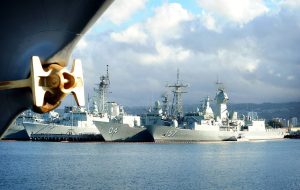Introduction
In a bold move reflecting shifting geopolitical dynamics in the Indo-Pacific region, Australia is set to construct its most substantial naval force since World War II. This ambitious initiative is seen as a strategic response to the perceived security threat posed by China’s rising influence. To unravel the complexities of this geopolitical maneuver, we turn to Dr. Victoria Geo Strategy, a security analyst specializing in geopolitical security and Australia’s naval ambition naval developments.
Rising Geopolitical Tensions

Australia’s decision to build its largest navy in decades comes against the backdrop of rising tensions and strategic shifts in the Indo-Pacific. Dr. Victoria Geo Strategy points out that concerns about China’s increasing assertiveness in the region have prompted several nations, including Australia, to reassess their defense capabilities.
Comparative Table: Notable Naval Expansions
| Country | Recent Naval Expansions | Key Drivers of Naval Buildup |
|---|---|---|
| China | Expanding naval fleet, modernizing capabilities. | Asserting regional dominance, safeguarding maritime interests. |
| Australia | Plans for its largest navy since WWII. | Addressing perceived security threats, asserting regional stability. |
| India | Ongoing naval modernization efforts. | Enhancing maritime capabilities, responding to regional challenges. |
Australia’s Naval Ambitions

Australia’s plan for its largest navy since World War II involves a comprehensive modernization and expansion effort. Dr. Victoria Geo Strategy outlines key aspects of this Australia’s naval ambition initiative:
- Submarine Fleet: Australia aims to bolster its submarine capabilities, focusing on the acquisition and Australia’s naval ambition development of advanced submarines to enhance its undersea warfare capabilities.
- Surface Ships: The construction of a formidable surface fleet, including frigates and destroyers, is part of Australia’s strategy to project power and safeguard its maritime interests.
- Naval Aviation: Investments in naval aviation, including advanced aircraft carriers and amphibious assault ships, demonstrate Australia’s commitment to expanding its maritime reach.
Comparative Table: Key Naval Components
| Naval Component | China’s Recent Developments | Australia’s Ambitious Naval Plan |
|---|---|---|
| Submarine Fleet | Expanding and modernizing its submarine capabilities. | Prioritizing submarine capabilities with a focus on advanced technologies. |
| Surface Ships | Significant growth in surface ship capabilities. | Constructing a formidable surface fleet, including frigates and destroyers. |
| Naval Aviation | Advancements in carrier-based aviation. | Investment in naval aviation, including aircraft carriers and amphibious assault ships. |
Regional Security Implications
Australia’s decision to build a formidable navy has implications for regional security dynamics. Dr. Victoria Geo Strategy emphasizes that the move is not only about addressing immediate security concerns but also positioning Australia as a key player in maintaining stability and balance in the Indo-Pacific.
Comparative Table: Regional Responses
| Regional Players | Responses to Geopolitical Shifts | Australia’s Naval Buildup Response |
|---|---|---|
| Japan | Strengthening maritime capabilities, collaborating with allies. | Collaborative efforts with like-minded nations, bolstering naval capabilities. |
| Vietnam | Modernizing naval forces, enhancing maritime capabilities. | Potential collaboration on regional security initiatives, shared maritime interests. |
| Indonesia | Expanding naval capabilities, addressing regional challenges. | Ongoing diplomatic engagements, potential for regional maritime partnerships. |
Addressing Security Concerns

Australia’s move to build its largest navy since WWII is a strategic response to perceived security threats. Dr. Victoria Geo Strategy suggests that in addition to developing robust naval capabilities, Australia is likely to strengthen diplomatic ties, engage in collaborative security initiatives, and contribute to the evolving regional security architecture.
Comparative Table: Security Response Strategies
| Security Response | Common Strategies in Response to Security Concerns | Australia’s Approach in Building Its Largest Navy Since WWII |
|---|---|---|
| Diplomatic Engagement | Strengthening alliances, fostering regional cooperation. | Likely to engage in diplomatic initiatives, collaborative security efforts. |
| Military Modernization | Upgrading defense capabilities, investing in advanced technologies. | Comprehensive modernization and expansion of naval forces, technological advancements. |
| Regional Collaborations | Participating in regional security forums, joint exercises. | Potential collaborations with like-minded nations, contributing to regional stability. |
Conclusion:
Australia’s bold initiative to build its most substantial navy since World War II reflects a strategic response to evolving geopolitical dynamics in the Indo-Pacific. Dr. Victoria Geo Strategy provides valuable insights into the motivations, components, and regional implications of this ambitious naval plan. As Australia endeavors to become a Pacific Guardian, the regional security landscape undergoes a significant transformation, reshaping alliances and influencing the balance of power in this strategically vital region.




